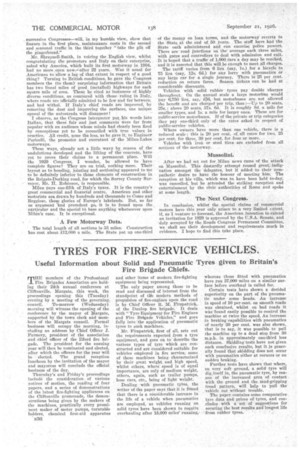TYRES FOR FIRE-SERVICE VEHICLES.
Page 54

If you've noticed an error in this article please click here to report it so we can fix it.
Useful Information about Solid and Pneumatic Tyres given to Britain's Fire Brigade Chiefs.
TEM members of the Professional Fire Brigades Association are holding their 24th annual conference at Clifton-rifle, Margate, this week, the proceedings opening this (Tuesday) evening by a meeting of the governing council. To-morrow (Wednesday) morning will witness the opening of the conference by the mayor of Margate, supported by the town clerk and members of the Margate council. Formal business will occupy the morning, including an address by Chief Officer 3. Farmery, president of the association and chief officer of the Ilford fire brigade. The president for the ensuing year will then be nominated and elected, after which the officers for the year will
be " elected. The grand reception luncheon by the invitation of the mayor and mayoress will conclude the official business of the day.
Thursday's and Friday's proceedings include' the consideration of various notices of motion, the reading of four papers, and a series of demonstrations of the latest fire-fighting appliances on the Cliftonville promenade, the demonstrations being given by the makers of the machines practically every prominent maker Of motor pumps, turntable ladders, chemical first-aid apparatus B36 and other items of modern fire-fighting equipment being represented.
The only paper among those to be read and discussed of interest from the standpoint of thie modern methods of propulsion of fire-engines upon the road is by Chief Officer R. M. Fitzpatrick, of the Dunlop fire brigade. It deals with "Pyre Equipment for Fire Engines and Fire Brigade Vehicles," and goes fully into the application of pneumatic tyres to such machines.
Mr. Fitzpatrick, first of all, sets out the requirements expected from a tyre equipment, and goes on to' describe the various types of tyre which are constructed and are considered suitable for vehicles employed in fire service, some of these machines being characterized by their great weight and high speed, whilst others, where speed is of equal importance, are only of medium weight, others, again, such as trailer pumps, hose ears, etc., being of light weight.
Dealing with pneumatic tyies, the writer of the paper says that it is found that there is a considerable increase in the life of a vehicle when pneumatics are employed, as vehicles running on solid tyres have been shown to require overhauling after 18,000 miles' running, whereas those fitted with pneumatics have run 37,000 miles on a similar surface before overhaul is called for.
Certain tests haVe shown a decided superiority on the part of the pneumatic under some heads. An increase in speed of 10 per cent, on smooth roads was obtained, whilst on bad roads it was found easily possible to control the machine at twice the speed. An increase in braking capabilities with pneumatics of nearly 30 per cent, was also shown, that is to say, it was possible to pull the machine up to a dead stop from 30 m.p.h. in approximately one;third less distance. Skidding tests have not given such conclusive results, but it is generally found that skidding does not occur with pneumatics either at corners or on
sudden braking. • Further tests have shown that where, on very soft ground, a solid tyre will dig.. itself in, the pneumatic tyre, by reason of the increased area of contact with the ground and the mud-gripping tread pattern, will help to pull the vehicle out svithcait trouble.
The paper contains some comparative tyre data and prices of tyres, and concludes with a set of suggeations for securing the beet results and longest life from robber tyres. * ' '




































































































